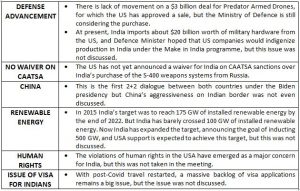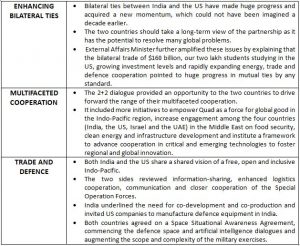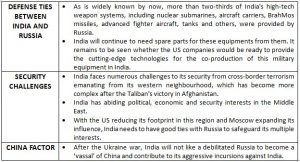DAILY CURRENT AFFAIRS (MAY 13, 2022)
THE INTERNATIONAL AFFAIRS
1. SECOND GLOBAL COVID VIRTUAL SUMMIT
THE CONTEXT: Prime Minister Shri Narendra Modi participated in the Second Global COVID Virtual Summit on the invitation of the President of U.S.A. Prime Minister delivered his remarks in the Opening Session of the Summit on the theme ‘Preventing Pandemic Fatigue and Prioritizing Preparedness’.
EXPLANATION:
HIGHLIGHTS OF PM SPEECH
- India adopted a people centric strategy to combat the pandemic and has made the highest ever allocation for its health budget this year.
- India was running the largest vaccination campaign in the world and had vaccinated close to ninety percent of its adult population and more than fifty million children.
- As a responsible member of the global community, India would continue to play an active role by sharing its low cost indigenous COVID mitigation technologies, vaccines and therapeutics with other countries. India is working to extend its genomic surveillance consortium.
- India has used traditional medicine extensively and has laid the foundation for a WHO Center for Traditional Medicine in India to make this knowledge available to the world.
- Prime Minister also called for strengthening and reforming the WHO to create a stronger and more resilient global health security architecture.
THE POLITY AND GOVERNANCE
2. WHO CAN NOTIFY MINORITIES?
THE CONTEXT: A public interest litigation (PIL) under the consideration of the Supreme Court of India challenges the power of the Centre to notify minority communities at a national level.
THE EXPLANATION:
Who is a minority and who decides that?
- The PIL specifically questions the validity of Section 2(f) of the National Commission for Minority Educational Institutions or NCMEI Act 2004, terming it arbitrary and contrary to Articles 14, 15, 21, 29 and 30 of the Constitution.
- Section 2(f) says “minority ,”for the purpose of this Act, means a community notified as such by the Central Government.” Section 2(c) of the of National Commission for Minorities (NCM) Act, 1992 also gives the Centre similar powers.
- In 2005, the Congress-led United Progressive Alliance (UPA) at the Centre notified five communities — Muslims, Christians, Sikhs, Buddhists and Parsis — as minorities at the national level. In 2014, the Manmohan Singh government notified followers of Jainism as a minority community, making them the sixth on the national list.
How has the Centre responded?
- The Centre said it had the power to notify minority communities. In the first, the Centre categorically defended the concept of minorities at the national level.
- The Centre has not taken a position, one way or the other, about continuing the national list of minorities while it reiterated its power to notify communities as minorities under Central Acts.
- The Centre had pointed out that it had concurrent powers with States to take measures for the welfare of minorities. States could have minorities notified as such within their jurisdiction
- The Centre said the pleas made by the petitioner must be rejected
What next?
- The Centre has said it would come back to the apex court “after consideration of several sociological and other aspects.” It said “any stand without detailed deliberations with stakeholders may result in an unintended complication for the country.”
3. RAJIV KUMAR APPOINTED AS NEXT CHIEF ELECTION COMMISSIONER
THE CONTEXT: The Union Ministry of Law and Justice announced Rajiv Kumar, the current Election Commissioner, will take over as the next Chief Election Commissioner (CEC) from May 15. Kumar will take charge from CEC Sushil Chandra, who is due to retire.
EXPLANATION:
- In pursuance of clause (2) of Article 324 of the Constitution, the President is pleased to appoint Shri Rajiv Kumar as the Chief Election Commissioner with effect from the 15th May, 2022. My best wishes to Shri Rajiv Kumar.
- Kumar took charge as the Election Commissioner of the Election Commission of India (ECI) on September 1, 2020.
- Prior to assuming charge in the Election Commission, Kumar had been the chairman of the Public Enterprises Selection Board. He joined as the PESB chairman in April 2020.
- Kumar, an officer of the 1984 batch of the Indian Administrative Service of the Bihar/Jharkhand cadre, superannuated from the IAS in February 2020.
ELECTION COMMISSION OF INDIA
- The Election Commission of India (ECI) is a self-governing constitutional body which oversees the election process in India as per the Constitution of India.
- The ECI was set up on January 25 1950, with the aim of defining and controlling the multi-tiered election process in our country.
- The Election Commission of India administers the election process from the President of India to the State Legislative Assembly.
- As per Article 324 of the Indian Constitution, ECI has the supervisory and directional control of the complete process election to Parliament and Legislature of every State and to the office of the President and the Vice-President of India.
Structure
- The ECI consists of a Chief Election Commissioner and 2 other Election Commissioners. The multi-member ECI works on the power of the majority vote.
Appointment & Tenure of Commissioners
- The Chief Election Commissioner and the Election Commissioner are appointed by the President of India.
- Each of them holds their offices for a period of 6 years or up to the age of 65 years, whichever comes first.
- They receive the same perks and pay as Supreme Court Judges.
- The only way a Chief Election Commissioner can be removed from office is upon an order of the President supported by the Parliament.
- The Election Commissioner or Regional Commissioner can only be removed from office by the Chief Election Commissioner.
Functions of the Election Commission of India
- ECI is responsible for a free and reasonable election
- It ensures that political parties and candidates adhere to the Model Code of Conduct
- Regulates parties and registers them as per eligibility to contest in elections
- Proposes the limit of campaign expenditure per candidate to all parties and monitors the same.
- It is mandatory for all political parties to submit annual reports to the ECI in order to be able to claim the tax benefit on the contributions.
- Guarantees that all political parties regularly submit audited financial reports.
The main duties of the Election Commission are:
- Supervise, control and conduct all elections to Parliament and State Legislatures
- Set general rules for election.
- Prepare electoral rolls
- Determine the territorial distribution of constituencies
- Give credit to political parties.
- Allot election symbols to political parties or candidates
- Appoint tribunals for the decision of doubts and disputes arising out of an election to Parliament and State Legislatures.
CHIEF ELECTION COMMISSIONER
- The Chief Election Commissioner of India heads the Election Commission of India.
- The Chief Election Commissioner is the first among the equal of the tree member of election commission.
- The President of India appoints the Chief Election Commissioner (CEC) of India who has a tenure of 6 years or up to 65 years, whichever is earlier.
- It is very difficult to remove the Chief Election Commissioner once appointed by the President of India, as two-thirds of the Lok Sabha and the Rajya Sabha members need to vote against CEC for disorderly conduct or improper actions.
- From the formation of the Election commission in 1950 till 1989, the Election Commission was a single-member body. Two additional commissioners were appointed by the President of India on 16 October 1989 but they had a very short tenure ending 1 January 1990.
- The Election Commissioner Amendment Act, 1989 made the Commission a multi-member body. The concept of a 3-member Commission has been in operation since then, with the decisions being made by a majority vote.
THE ECONOMIC DEVELOPMENT
4. RETAIL INFLATION QUICKENS TO AN ALMOST EIGHT-YEAR HIGH AT 7.8%
THE CONTEXT: The retail inflation rate galloped to a 95-month high in April at 7.8 per cent, paving the way for more policy rate hikes by the central bank even as factory output growth remained lacklustre at 1.9 per cent in March, signalling weak domestic demand.
EXPLANATION:
- What is Retail Inflation?
- An inflation rate is indicative of the rise in prices of commodities in an economy. Retail inflation, specifically, is measured in consumer price index (CPI), which is a weighted average of prices of a basket of consumer goods and services. Therefore, retail inflation is also termed CPI-based inflation.
- The CPI is the change in retail prices of goods and services which households purchase for their daily consumption, such as food articles, fuel, and services such as transportation and health care, among others.
- The Ministry of Statistics and Programme Implementation (MoSPI) is responsible for compiling this data, which is measured by the rate of change in CPI over a period of time.
- The Reserve Bank of India monitors this figure in view of sustaining a balance in commodity prices in the economy.
- Trends in Retail Inflation
- According to the Monetary Policy Report for April 2021, the inflation rate should be sustained between 2 to 6 percent, with the ideal inflation rate being 4 percent till March 2026.
- Since January 2022, this percentage has witnessed a steady rise and remained above 6 percent.
- In April, the MoSPI calculated the retail inflation of March to be 6.95 percent, which was a 17-month high. The food inflation in February was 6.07 per cent and in January, when it first breached the RBI limit, the retail inflation was 6.01 per cent.
- A year ago in April 2021, the CPI-based inflation was well within the benchmarks set by the RBI – standing at 4.29 percent. This was an ease from the inflation rate during the same time in the previous year, 2020.
- What’s the reason behind the rise?
- Inflation happened because of global factors like commodities (such as agricultural produce) price rise, energy price rise and interest rate hikes by the United States Federal Reserve, as well as supply side factors caused by COVID-induced lockdowns.
- The war in Ukraine has contributed significantly to the surging inflation.
- Ukraine is one of the major sunflower oil producers in the world and India imports a major portion of the commodity from the war-ravaged country.Besides, Ukraine is a key supplier of fertiliser to India.
- The Ukraine-Russia war has also caused disruptions in the supply chain.
- The Russia-Ukraine war and the lockdown in China have resulted in shortages of coal for power, shortages of semiconductor chips for industry (especially cars) and international shortages (food, oil, edible oil, construction materials).
- Effects of inflation
- The very immediate effect of inflation is the reduction in people’s purchasing power. It is well understood that if items keep becoming more expensive, people won’t buy or choose to ration those purchases. This, in turn, will reduce overall demand.
- The common man is the worst sufferer of inflation, as he has to struggle with managing a household with limited purchasing abilities.
- High inflation rates will also worsen the exchange rate. High inflation means the rupee is losing its power and, if the RBI doesn’t raise interest rates fast enough, investors will increasingly stay away because of reduced returns.
5. FOREX RESERVES FALL BY $28.05 BILLION IN SEPTEMBER 2021-MARCH 2022 PERIOD: RBI REPORT
THE CONTEXT: The country’s foreign exchange reserves declined by $28.05 billion to $607.31 billion at the end of March this year from $635.36 billion at the end of September 2021, according to an RBI report.
EXPLANATION:
- Reserve Bank of India (RBI) publishes half-yearly reports on management of foreign exchange reserves as part of its efforts towards enhanced transparency and levels of disclosure.
- These reports are prepared every six months with reference to the position as on March and September-end each year. The present report, which is 38th in the series, is with reference to the position as on end-March 2022.
- Although both US dollar and Euro are intervention currencies and the Foreign Currency Assets (FCA) are maintained in major currencies, the foreign exchange reserves are denominated and expressed in US dollar terms.
- Movements in the FCA occur mainly on account of purchase and sale of foreign exchange by RBI, income arising out of the deployment of the foreign exchange reserves, external aid receipts of the central government and changes on account of revaluation of the assets.
- The net forward asset (receivable) of RBI in the domestic foreign exchange market stood at $65.79 billion at the end of March 2022.
- At the end of December 2021, foreign exchange reserves cover of imports (on balance of payments basis) declined to 13.1 months from 14.6 months at end-September 2021.
- In value terms ($), the share of gold in the total foreign exchange reserves increased from about 5.88 per cent as at end-September 2021 to about 7.01 per cent as at end-March 2022.
- As of end-March 2022, out of the total FCA of $540.72 billion, $363.03 billion was invested in securities, $140.54 billion was deposited with other central banks and BIS, and the balance $37.16 billion comprised deposits with commercial banks overseas.
THE SCIENCE AND TECHNOLOGY
6. SCIENTISTS RELEASE THE FIRST IMAGE OF THE MILKY WAY’S SUPERMASSIVE BLACK HOLE
THE CONTEXT: Over 300 scientists from across the globe have captured the image of Sagittarius A* (Sgr A*), the supermassive black hole sitting in the heart of the Milky Way galaxy about 27,000 light-years away from the Earth.
EXPLANATION:
- Sgr A*, which is about four million times the mass of our sun, is starving, scientists said. Supermassive black holes typically feed on dust and gas from their surroundings.
- It is like the black hole is eating one grain of rice every million years, Sara Issaoun, NASA Einstein Fellow at the Harvard & Smithsonian Center for Astrophysics, Boston, United States, said in a press briefing. She was a part of the international Event Horizon Telescope (EHT) group that imaged the black hole.
- The image produced is a strong proof of Einstein’s Theory of Relativity, which had predicted that a massive yet compact object occupying the centre of the galaxy, Preeti Kharb from the National Centre for Radio Astrophysics, Tata Institute of Fundamental Research.
- The image is thanks to eight radio telescopes located in remote corners of the world, which combined to form a single ‘Earth-sized’ virtual telescope called EHT.
- A thick cloud of gas and dust envelopes Sgr A*, preventing ordinary telescopes from viewing it. Radio telescopes, on the other hand, allow astronomers to observe the naturally occurring radio waves emitted from stars, planets, galaxies, clouds of dust and molecules of gas.
- The EHT observed our supermassive galaxy on multiple nights in 2017, collecting data for many hours in a row. The researchers collected 6,000 terabytes of data from this exercise.
THE PRELIMS PRACTICE QUESTIONS
QUESTION FOR 13th MAY 2022
Q. Which of the following country does not have a border with Baltic Sea?
- Sweden
- Finland
- Denmark
- Norway
ANSWER FOR THE 12TH OF MAY
Answer: D
Explanation:
Under Medical Termination of Pregnancy (Amendment) Act, 2021, opinion Needed for Termination of Pregnancy:
- Opinion of one Registered Medical Practitioner (RMP) for termination of pregnancy up to 20 weeks of gestation.
- Opinion of two RMPs for termination of pregnancy of 20-24 weeks of gestation.
- Opinion of the State-level medical board is essential for a pregnancy to be terminated after 24 weeks in case of substantial foetal abnormalities.


